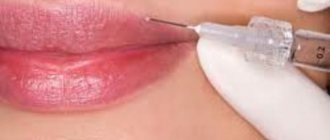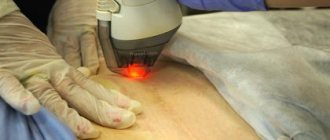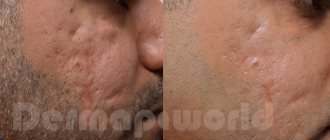What does laser eyelid resurfacing provide?
The procedure is carried out using a laser. It evaporates the top layer of skin, but does not damage it and does not affect blood microcirculation in the treated area. Wherein:
- pigment spots and networks of blood vessels disappear;
- skin area decreases by 10–20%;
- Collagen production is enhanced and elastin fibers are strengthened.
As a result, the skin tightens, becomes smooth and fresh. Laser eyelid rejuvenation has many advantages:
- The procedure is performed under local anesthesia and is therefore completely painless.
- The effect of grinding lasts about five years.
- The doctor controls the depth of penetration of the laser beam. The strength of the effect corresponds to the severity of wrinkles.
- Treated areas of skin do not differ in color from untreated areas, the face looks natural.
- You can tighten your eyelids at any age.
- The treated surface heals in 2 weeks.
How does the technique work?
Fractional CO2 systems generate a laser beam that is divided into many microbeams. When micro-rays hit the skin, they affect it, evaporating thin “columns” to a given depth, stimulating the production of new collagen. The remaining areas not exposed to micro-rays promote rapid tissue restoration and healing.
Over the next 3-6 months, collagen remodeling continues in the skin.
Contraindications
On the list of anti-aging procedures, one of the most popular and affordable is laser eyelid resurfacing. The price in Moscow may be higher than in other regions of Russia. But in the capital it is easier to find an experienced, highly qualified doctor. The head of the Center for Aesthetic and Laser Medicine, Kirill Listratenkov, is a candidate of medical sciences, a certified facial-maxillary and plastic surgeon, a specialist in laser surgery. When you contact the clinic, you will be confident in the results.
Before setting a date for the procedure, the doctor will definitely conduct an examination. This is necessary to eliminate possible risks. Laser resurfacing cannot be done:
- for diabetes mellitus;
- infectious diseases, including chronic ones in the acute stage;
- oncology;
- allergies to certain drugs;
- eyelid skin diseases;
- pregnancy.
Doctors also do not recommend resurfacing for patients with dark skin or a tendency to form scars. But this is not a categorical prohibition. It all depends on the specific situation.
How is the procedure done?
If everything is in order, the doctor will set a treatment date for you. No special preparation is required. If you are taking any medications, tell your doctor about it just in case. Perhaps he will advise you to interrupt treatment for a day or two.
To tighten the skin of the eyelids, you need to carry out several procedures. The interval between them is from 1 to 10 days. It depends on the characteristics of the organism. The doctor draws up the correct schedule for each patient individually.
During the procedure, the surgeon:
- Place special protective lenses on the patient's eyes.
- Apply anesthetic to the treatment area.
- Will apply markings. Grinding the upper eyelids, like the lower ones, requires great precision.
After completing the procedures, the doctor will apply an antiseptic to the skin. All this will take from 20 to 30 minutes.
Three important tips:
- Resurfacing the lower eyelid, like the upper, is a photosensitive procedure. This means that the skin becomes very sensitive to sunlight. If you want to tighten your eyelids, do it in the fall or spring. Bright summer and winter sun will reduce the effectiveness of the procedure.
- If you have had a chemical peel, wait 2 months before resurfacing. The skin must recover.
- You should not use decorative cosmetics for 2–3 weeks after the procedure, so as not to provoke dermatitis.
Laser blepharoplasty
Laser blepharoplasty is a plastic surgery term that refers to surgery to correct eyelid defects. The skin is cut with light rays, tightened and fixed in a new place. But popularly, this term is often used to refer to a completely different procedure, cosmetic - laser resurfacing (or dermabrasion) of the eyelids, which is fundamentally different from surgery. It is grinding that will be discussed in our article, and for convenience we will use the concept of “blepharoplasty” that is familiar to most. Both men and women of different ages often seek this procedure. In this sense, laser blepharoplasty is an effective non-surgical method of rejuvenating the upper and lower eyelids using a light beam. Under the action of the laser, excess soft tissue “evaporates”, as a result the skin shrinks, its relief and turgor improve, and many more problems in the area around the eyes are solved.
Laser hardware cosmetology
How does a laser work?
The meaning of the procedure is the targeted effect of light beams on the epidermis and dermis.
In this case, tissue coagulation occurs, but without cuts or punctures. A laser beam of a certain wavelength is able to influence which chromophore like water, a chromophore is a structure that absorbs a certain wavelength of light. When exposed to a laser beam, water heats up and evaporates with the formation of multiple small areas of dry necrosis.
Advantages and effectiveness of the method
This is the least traumatic method of rejuvenation, which is why many women are inclined in favor of laser blepharoplasty. Advantages of the procedure:
- easy to bear;
- if necessary, appile anesthesia can be used;
- no postoperative sutures, scars, hematomas;
- no complications;
- short rehabilitation period;
- quick result.
The effectiveness of laser blepharoplasty is increased due to its triple action.
Firstly, the area of treated skin is reduced by 5–15%. Secondly, the production of new young collagen and elastin by fibroblasts is stimulated. Thirdly, microcirculation in tissues improves. After laser resurfacing, the skin around the eyes becomes smooth, tightened, and acquires a healthy shade. With minimal interventions, the effect of laser blepharoplasty, depending on age and initial age-related changes, lasts from 2 to 5 years. Depending on the age, genetics and hormonal status of the patient, the number of procedures varies from 1 to 3 per session.
Types of laser exposure
For laser blepharoplasty, two types of beams are used:
- Carbon dioxide or CO2 laser. The wavelength is 10,600 nm; a beam of this wavelength has high thermal output and is capable of aggressively damaging surrounding tissues. Fewer procedures can be performed, but the recovery period will be longer
- Erbium. It has a wavelength of 2,940 nm, the chromophore is also water, but it works more softly and controlled, the recovery period is more gentle, and is considered the gold standard for working on delicate areas.
When is laser eyelid resurfacing needed?
The main goal of laser blepharoplasty is to restore youth to the area around the eyes.
Since it is the thin skin of the eyelids that is more susceptible to aging, as a result of exposure to various environmental factors, it is this area that shows the first age-related changes.
However, grinding can be resorted to at any age, even at a young age, to eliminate cosmetic defects. It will help in the fight against such phenomena:
- excessive dryness of the skin of the eyelids and a decrease in its tone, resulting in noticeable folds and lines;
- facial wrinkles that can form due to negative external factors (ultraviolet radiation, cold, tobacco smoke, habit of squinting);
- “swelling” of the upper and lower eyelids;
- “dark circles” and “bags under the eyes” - we are talking about small hernial sacs; if severe, surgery is needed;
- pigmentation, general unevenness of tone;
- presence of scars;
- correction of an inaccurately healed line in the folds of the eyelid after plastic surgery. This may occur in some patients due to genetics and metabolism. The laser removes excess connective tissue and makes it softer.
Using laser blepharoplasty, you can remove signs of aging and defects, the cause of which lies directly in the skin of the eyelids and is not associated with disruption of the internal organs. For example, severe swelling caused by improper functioning of the kidneys cannot be permanently eliminated using a laser. The procedure will not help with severe ptosis - very severe sagging of the skin of the eyelids; surgery will be required here.
Contraindications
Laser blepharoplasty does not have a wide range of specific contraindications; only sometimes it needs to be canceled or postponed until recovery.
Absolute contraindications include:
- individual intolerance to laser;
- period of pregnancy and lactation;
- oncology;
- serious systemic diseases (epilepsy, psoriasis, diabetes mellitus, autoimmune pathologies);
- genetic predisposition of the skin to the formation of keloid scars.
It is necessary to postpone laser blepharoplasty of the eyelids:
- during a viral or infectious disease (ARVI, influenza, bronchitis);
- during the period of exacerbation of chronic pathologies;
- for dermatological problems on the skin of the eyelids;
- within 2 months after plastic surgery, chemical peeling or other similar cosmetic procedures on the face;
- within 2 weeks after intense tanning under the sun or in a solarium.
When is the best time to have blepharoplasty?
Experts are unanimous in their opinion that the best period for laser blepharoplasty is autumn, winter and spring.
Preparatory stage
At the initial consultation, the cosmetologist talks with the patient and conducts an examination to exclude contraindications.
Medication may be recommended. In addition, the doctor will issue a list of recommendations that are followed until the day of laser resurfacing and throughout the entire rehabilitation period:
- do not sunbathe;
- stop taking hormones, antispasmodics, anticoagulants;
- do not drink alcohol.
There is no need to take tests or undergo examinations.
Equipment and procedure
The laser device consists of three blocks:
- electric - power is supplied through it;
- worker - here electricity is converted into a beam of light;
- optical - with the help of mirrors, light is reflected many times, turning into a wave of a certain frequency and length.
There are several radiation sources on the nozzle, so the treated area does not look like a solid line or area, but many small dots.
The entire process, including patient preparation, takes from 30 minutes to 1 hour. The doctor’s action algorithm will be as follows:
- cleansing the skin of the eyelids with mild cosmetics;
- antiseptic treatment;
- use of local anesthesia if necessary;
- setting up the device - the doctor selects the appropriate radiation range and wavelength;
- processing of the planned areas with the device, while protecting the eyes.
During the procedure, you may feel tingling, heating of the skin, and discomfort. At the final stage, the doctor assesses the condition of the tissues and the patient’s well-being, makes recommendations, after which you can go home. The total time spent in the clinic will be 1-1.5 hours.
Recovery period
Immediately after laser blepharoplasty, eyelid redness and swelling are observed.
This will pass within 2–3 days. By the end of the first day, swelling increases, which resolves within 3-5 days. Also at this time, microscopic crusts form, but they cannot be removed - they must come off on their own. During the rehabilitation period, which lasts 5-10 days, follow the doctor’s recommendations:
- on the first day, do not touch the skin around the eyes, avoid the use of any cosmetics - decorative, for care;
- from the second day you can wash your face with soft cool water and use gentle moisturizers;
- For another month, only light makeup is allowed. The main thing here is to carefully rinse off the pigment, do not rub the skin, or use aggressive agents;
- for 3–4 weeks, avoid baths and saunas, exposure to the sun or visiting a solarium;
- postpone sports and heavy physical labor.
Complete tissue restoration is achieved in 2-3 weeks, with deep resurfacing - 4-6 weeks, the full effect after laser blepharoplasty begins from 6 weeks and increases by 3 months
Possible complications
Depending on the genetics and metabolism of the patient, complications may manifest as swelling over a long period.
If the recommendations are not followed, they can manifest themselves in the form of severe swelling and pigmentation. Remember that such procedures must be carried out by an experienced specialist. An experienced doctor will identify contraindications, prescribe preventive treatment and carry out the procedure technically correctly, which together will minimize all risks.
VIP Academy employs highly qualified doctors with 15 years of experience in performing laser dermabrasion of the lower and upper eyelids.
We use only certified techniques; the device has a cooling option, which makes the procedure more comfortable. The clinic is located in Nizhny Novgorod at the address: st. Studenaya, 57. Find out more details about the procedure by calling 8 (831) 219-91-50.











